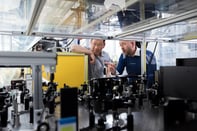Published on
Fostering Community and Student-Centered Models in Higher Ed

Higher ed institutions need to focus on meeting all learners’ needs, not just those of the traditional student population. They must therefore build flexibility into curricula, have the right technology in place and ensure the education they provide leads to mobility.
The importance of building strong community and encouraging student empowerment cannot be overstated. As higher education institutions strive to meet the modern learners’ diverse needs, these factors have become pivotal in driving both student success and institutional growth. In this interview, Scott Pulsipher discusses higher ed’s need to adapt, challenges to creating pathways and how the institution can come together to better serve learners.
The EvoLLLution (Evo): How have institutions needed to adapt to respond to the modern learner, for example, the underserved and full-time working demographic?
Scott Pulsipher (SP): In recent years, institutions have needed to adapt significantly to meet the needs of those who do not fit the traditional student mold, that is, the under-24-year-old emerging adult attending a residential brick-and-mortar campus.
Historically, higher education systems have catered to these younger, part-time working and full-time enrolled students, neglecting the broader student population’s diverse circumstances and needs. This disparity has resulted in inequitable access and outcomes, putting in stark contrast those who higher education includes and those whom it leaves behind. The composition of today’s enrollment is quite different than the conventional assumption.
To address this new traditional learner, institutions must fundamentally rethink their structures and align their efforts with higher education’s primary purpose: activating and preparing talent and enabling opportunity. Universities like the one I lead, Western Governors University or WGU, are leading this transformation by developing designs, methods and models focusing on the student as the primary beneficiary by improving learning relevancy, personalizing the student experience and increasing affordability. Achieving these goals at scale involves designing systems and processes that both improve curricula quality and relevancy and adapt instruction and learning to increase success for every student within the large and diverse student body.
WGU was created by 19 governors who knew that adaptation within their state systems was imperative to provide access to higher education for more individuals among their respective populations. To do so both locally and nationally at scale, we do things differently, starting by using technology to provide the flexibility that digital-first learning design affords, designing around competency-based education where students are measured on demonstrated mastery rather than time, and employing a unique, disaggregated faculty model that includes mentors, possessing both the academic credentials and the work-relevant experience, who provide personal support from enrollment through graduation.
Evo: What are some challenges to creating pathways for these learners and meeting their needs?
SP: Addressing the challenges of creating pathways for learners means shifting the focus from institutional convenience to student empowerment. Education should break through the constraints of time and place, offering flexible schedules that allow students to learn when it suits them. Personalized instructional models, such as 24/7 support and self-directed learning resources, are crucial to helping students manage their education alongside other personal responsibilities. This approach requires a departure from conventional practices, such as moving away from selective admissions and fixed class schedules, in favor of open enrollment and flexible, student-driven learning models, allowing institutions to better meet each and every individual’s needs.
Evo: What do students expect of their institution when it comes to supporting their needs inside and outside the classroom?
SP: Students first and foremost expect that their education will result in opportunity and mobility. With the recognition that each student is an individual, it’s incumbent on institutions to provide personalized education and support tailored to their individual needs. At WGU, we embrace a students-as-customers approach, treating students as the primary beneficiaries of our services.
Evo: What’s required of an institution and all its departments to overcome these obstacles and create pathways of opportunity?
SP: An institution must first and foremost clarify its primary purpose. This clarity serves as the foundation upon which all other decisions are made, ensuring that every department, policy and initiative aligns with the institution’s core mission. In the case of postsecondary institutions, our primary purpose is to connect talent with opportunity, enabling individuals to achieve social and economic mobility. Therefore, every aspect of the institution should focus on improving student persistence, completion, competency, satisfaction and enhancing value for students and graduates.
Evo: What role does technology play in serving the modern learner effectively?
SP: Higher education has long struggled to keep pace with the evolving needs of America’s diverse learners, often catering to a younger, traditional student body that no longer reflects today’s reality. To truly meet modern learners’ needs, technology must be at the forefront, driving a transformation that makes education more personalized, flexible and inclusive. Technology empowers institutions to deliver tailored educational experiences that resonate with today’s students, enhancing both engagement and learning outcomes. With advancements such as machine learning and AI, technology’s role becomes even more critical, as it must both increase personalization of content, instruction and experience, and it must ensure education remains relevant and impactful in a rapidly changing world. Institutions must fully embrace technological innovation, integrating it into every aspect of the educational journey to prepare students for the future. “Student-centered and tech first” would be an effective design mantra for any institution.
Evo: What trends do you expect to see when it comes to institutions serving this new modern learner?
SP: Institutions wanting to successfully serve the modern learner at scale are likely to embrace several key trends in the coming years, including innovating across dimensions of student experience, relevance and cost. This will look like implementing timely and relevant interventions across the learning journey, aligning learning outcomes with evolving workforce demands and ensuring the value of a credential outweighs its cost. Ultimately, from a student’s perspective, postsecondary education may be a pathway or journey or experience, one they see as integrated and weaving together knowledge, experience, skill and ability. One that prepares them for the next step of their lives. This integrated, student-centered approach combined with curricula relevant to opportunity is a puck to which all must skate.



